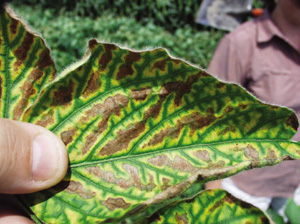
Features
Agronomy
Diseases
Fusarium in soybeans not new, not appreciated
Species and conditions vary for it to have impact.
March 10, 2008 By Ralph Pearce
In all three of the major crops in eastern Canada – corn, soybeans and wheat – fusarium can be a problem. It is a disease that has the same name, yet all are very different in terms of the impact on their respective crops. In wheat, F. graminearum is the pathogen for fusarium head blight. In corn, F. verticillioides is the cause of fusarium ear rot. Yet in soybeans, there are two primary pathogens: F. oxysporum, which causes fusarium wilt or blight of soybeans, and F. virguliforme, the culprit behind sudden death syndrome (SDS).
It is not that fusarium is a new disease for soybeans, it is that 2007 was a year in which many growers were impacted by it, while researchers and pathologists try to learn more about it. When it comes to diseases, fusarium is abundant in numbers, with more than 20 different known species. Although they have been identified, the sheer numbers can make specific identification of one species or causative agent more of a challenge among growers.
According to Albert Tenuta, field crops pathologist with the Ontario Ministry of Agriculture, Food and Rural Affairs (OMAFRA), fusarium has become one of those disease complexes that growers tend to overlook. “As far as I’m concerned, fusarium complex or fusarium root rot in soybeans are two diseases that have not been fully understood or fully appreciated over the years,” he says, adding that many of his colleagues are quickly arriving at the same conclusion. “It’s only now that many people are starting to realize that fusarium truly does have a potentially significant impact on soybean production, not only in Ontario but in North America.”
 |
| Fusarium wilt is often confused with phytophthora root rot, even though wilt usually occurs in a dry summer while phytophthora is more common in wet years. |
Wide point of infection
In soybeans, fusarium can infect the field at any point in the growing season. “It’s a great pathogen that can affect the plant at any stage of development and particularly when it is under stress,” says Tenuta. “The other thing is it can also weaken the plant, so there are many other different interactions going on, so other diseases may be worse under a fusarium infection.”
What makes this situation worse is that although the various species have been identified, there is little to be done about preventing them. Horst Bohner, soybean specialist with OMAFRA, notes that 2007 was made more difficult because of the dry conditions in which the disease can actually do more damage than in a normal year. As well, fusarium in soybeans is often mis-diagnosed as phytophthora root rot or some other problem. “At a quick glance, the above ground symptoms can look similar to phytophthora or even soybean cyst nematode (SCN) damage. Yet in every case where the diagnosis was not one of the more easily diagnosed pests, it turned out to be fusarium in 2007,” says Bohner. “A good rotation will help to minimize these kinds of problems.”
He adds that in 2008, it will likely be another disease that becomes the primary focus for growers. Yet what is particularly troubling for Bohner is that ‘out of sight’ does not mean it is ‘out of mind’. Just because fusarium may not be a problem in 2008 does not take away from the bottom line that there is little that growers can do about it. “It’s a different species than in corn and we don’t have soybean varieties that we can say are completely resistant,” states Bohner. Although he concedes it is a cyclical disease, Bohner also notes that as more acres of soybeans are grown north of Highway 89 and east of Toronto, the incidence of diseases that can hurt yields will increase as well. Yet as Tenuta points out, the Ontario soybean crop is a relative newcomer, which is why some of the diseases are beginning to show with greater frequency. “You’re just talking about the past 30 years, so from an evolutionary standpoint versus long-term, that’s still pretty new,” he says.
 |
| Sudden death syndrome caused by the fusarium species creates a distinctive pattern of interveinal browning and necrosis on the upper leaf surface of soybeans. Photos Courtesy Of Albert Tenuta, OMAFRA. |
Twenty years ago, disease problems in the US Midwest began increasing in much the same way, and then started migrating north into Ontario. “In eastern Ontario, they’re where we were 15 or 20 years ago in southwestern Ontario, and the eastern region is where some of the best yields have been seen in over the past four or five years. But we are seeing things starting to change and as long as the environment is conducive for diseases or pests to survive, over time, they will find their way there.” -end-
We are very conscious of fusarium in our seed soybeans. We plant all the soybeans in rows to allow air movement through the plants. Some years, row crop cultivation also helps when done early. Grahame Hardy, Inkerman, Ontario.
One more reason for a good rotation. Alan McCallum, Iona Station, Ontario.
I have been guilty of scouting too many soybeans from the pickup, especially since the advent of Roundup Ready. With aphids, spider mites, bean leaf beetle, fusarium/SDS, phytophthora, rhizoctonia, SCN, stem canker, brown stem rots, AND $11+ beans, I need to get a lot more green stains on my socks. Ken Nixon, Ilderton, Ontario.